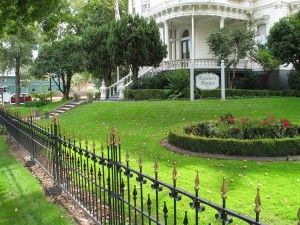State Threatens Parks Closures
It was an unseasonably cool and rainy Sunday afternoon, and there were about two dozen of us standing under the entry porch of the Governor’s Mansion on Sunday. Usually just two or three tourists show up these days, and the tour guide couldn’t believe the size of the crowd. “Is this how it’s going to be all summer?” the guide asked us.
The reason for the sudden crowd was obvious. The mansion, located at 16th and I streets and used for about 64 years from governors George Pardee to Ronald Reagan, appeared on last week’s new list of 70 state parks and historic buildings that will have to close some time in the near future because of budget cuts. The closings, which constitute a quarter of the state’s 278 parks, will save an estimated $11 million in the fiscal year 2011-12, and another $22 million in 2012-13.
Indeed, as we walked through the old Governor’s Mansion — derided as a “firetrap” by Nancy Reagan, who lived there with her husband just three months before finding more modern lodgings — we found that much of it was never opened to the public in the first place. Though equipped with a full basement and five above-ground floors (the highest being a small room), just two floors are open to public visits. The third floor ballrooms and billiards room remain completely empty, still awaiting restoration despite the fact that the mansion has been part of the state parks department since the Reagans vacated the building in 1967.
Other Closings
As for the other parks slated for closure, the parks department released a substantial list. The early state capitol building in Benicia made the list, as did the mansions of former Gov. Leland Stanford and Pio Pico, the last Mexican governor of California. The eerie Mono Lake Tufa State Nature Reserve is on the list, as are the gorgeous Redwood forests at Hendy Woods in Mendocino and Grizzly Creek Woods near Eureka. Even the old Shasta ghost town made the list.
Of course, closing state parks is not exactly a new threat. In 2009, then-Gov. Arnold “The Lovenator” Schwarzenegger proposed closing an astonishing 220 parks to save money. That threat disappeared when a budget deal laden with gimmicks finally passed.
Indeed, our guide acted as though the latest announcement was no different than those given fairly regularly over the last few years. “We have no idea when they would close us,” the guide told us. “They said we’d be closed last year, and we’re still here.”
That this would be a threat to rally Democrats against the anti-tax Republicans seems pretty clear from the Parks and Recreation Department’s May 13 press release announcing the closures. The money quote comes from John Laird, the State Resources Agency Secretary: “Hopefully, Republicans in the legislature will agree to allow California voters to decide whether we extend currently existing taxes or make deeper cuts to our parks.”
Nothing galvanizes the left like a frontal assault on parks and historic buildings. They are sacred places, shrines to either history or nature that must be protected at all costs. Indeed, Democrats in the Senate have already killed Republican proposals to keep the parks open — simply because they won’t play ball on taxes.
But the ironic thing here is that closing parks is totally unnecessary and, in fact, rather stupid. That’s because non-profit organizations are completely capable of running historic sites and parks.
For instance, there’s the aircraft carrier USS Hornet in Alameda. Though unquestionably a historic location — the ship recovered the Apollo 11 command module after it’s 1969 trip to the moon — it is today run as a museum by the non-profit Aircraft Carrier Hornet Foundation.
Ironically, it was Schwarzenegger who put this into practice last summer, though with typically feckless results. Seeking to augment the finances of struggling Fort Ross State Historic Park — the location of an early Russian trading post — Schwarzenegger signed a deal with the new non-profit Renova Fort Ross Foundation. This would have been great, except that the parks department failed to realize they were signing on with a Russian company under fire for disclosure law violations in Switzerland.
Due Diligence
Fort Ross was the right idea, but the state needs to do far more due diligence on their potential non-profit partners. The state seems to understand this, and parks officials noted the possibilities of non-profits taking over state parks in the May 13 statement.
“With this announcement, we can begin to seek additional partnership agreements to keep open as many parks as possible,” said State Parks Department head Ruth Coleman. “We already have 32 operating agreements with our partners — cities, counties and non-profits — to operate state parks, and will be working statewide to expand that successful template.”
That’s great, but why didn’t the state just do that to begin with?
— Anthony Pignataro
Related Articles
Conflicted Pols Pushed To Resign
SEPT. 30, 2010 By ANTHONY PIGNATARO Apparently, the state attorney general only recently discovered that two California High-Speed Rail Authority
High-speed rail agency lacks leader at crucial juncture
Four months after then-California High Speed Rail Authority Chief Executive Jeff Morales told authority board members he was moving on
Housing report by Legislative Analyst raises affordability questions
The California Legislative Analyst’s new report on housing costs puts numbers to what housing-hunters know on the ground: affordable housing





